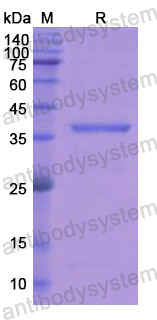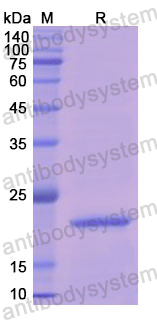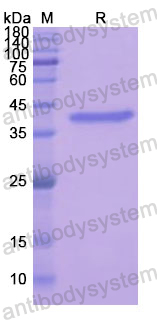Catalog No.
YHC24501
Expression system
E. coli
Species
Homo sapiens (Human)
Protein length
Met1-Ala311
Predicted molecular weight
37.40 kDa
Nature
Recombinant
Endotoxin level
Please contact with the lab for this information.
Purity
>90% as determined by SDS-PAGE.
Accession
P07307
Applications
ELISA, Immunogen, SDS-PAGE, WB, Bioactivity testing in progress
Form
Lyophilized
Storage buffer
Lyophilized from a solution in PBS pH 7.4, 0.02% NLS, 1mM EDTA, 4% Trehalose, 1% Mannitol.
Reconstitution
Reconstitute in sterile water for a stock solution. A copy of datasheet will be provided with the products, please refer to it for details.
Shipping
In general, proteins are provided as lyophilized powder/frozen liquid. They are shipped out with dry ice/blue ice unless customers require otherwise.
Stability and Storage
Use a manual defrost freezer and avoid repeated freeze thaw cycles. Store at 2 to 8°C for frequent use. Store at -20 to -80°C for twelve months from the date of receipt.
Alternative Names
CLEC4H2, HL-2, C-type lectin domain family 4 member H2, ASGPR 2, ASGP-R 2, Hepatic lectin H2, Asialoglycoprotein receptor 2, ASGR2
Selected cell receptor genotypes differentially modulate the ABO blood group influence on Factor VIII levels in severe aortic stenosis., PMID:40398046
Serum ASGR2 level: an efficacy biomarker for balloon pulmonary angioplasty in patients with chronic thromboembolic pulmonary hypertension., PMID:38855107
Targeted protein degradation systems to enhance Wnt signaling., PMID:38847394
Notch1 regulates hepatic thrombopoietin production., PMID:38603632
Asialoglycoprotein Receptor 2 Expression in Patients With Locally Advanced Gastric Cancer After Curative Resection., PMID:38159992
Identification of Immune-Linked Hub Genes and Diagnostic Model Construction in Schizophrenia., PMID:37552420
Co-Expression Network Analysis Identifies Molecular Determinants of Loneliness Associated with Neuropsychiatric and Neurodegenerative Diseases., PMID:36982982
Modulation of factor VIII pharmacokinetics by genetic components in factor VIII receptors., PMID:36533781
Genome-Wide Analysis and Expression Profiling of Glutathione Reductase Gene Family in Oat (Avena sativa) Indicate Their Responses to Abiotic Stress during Seed Imbibition., PMID:36232950
The p.P1127S pathogenic variant lowers von Willebrand factor levels through higher affinity for the macrophagic scavenger receptor LRP1: Clinical phenotype and pathogenic mechanisms., PMID:35596664
Enhanced ASGR2 by microplastic exposure leads to resistance to therapy in gastric cancer., PMID:35547772
Human iPSC-derived hepatocyte system models cholestasis with tight junction protein 2 deficiency., PMID:35284810
The Asialoglycoprotein Receptor Minor Subunit Gene Contributes to Pharmacokinetics of Factor VIII Concentrates in Hemophilia A., PMID:34407556
The exosome encapsulated microRNAs as circulating diagnostic marker for hepatocellular carcinoma with low alpha-fetoprotein., PMID:32441313
Identification of hub genes correlated with the pathogenesis and prognosis of gastric cancer via bioinformatics methods., PMID:31638362
Enhanced Potency of GalNAc-Conjugated Antisense Oligonucleotides in Hepatocellular Cancer Models., PMID:31303442
Pattern-Specific Transcriptomics Identifies ASGR2 as a Predictor of Hematogenous Recurrence of Gastric Cancer., PMID:29784667
Asialoglycoprotein receptor 1 mediates productive uptake of N-acetylgalactosamine-conjugated and unconjugated phosphorothioate antisense oligonucleotides into liver hepatocytes., PMID:29069408
Functional Consequences of Mannose and Asialoglycoprotein Receptor Ablation., PMID:27405760
Asialoglycoprotein receptor facilitates infection of PLC/PRF/5 cells by HEV through interaction with ORF2., PMID:27155063
Expression pattern of asialoglycoprotein receptor in human testis., PMID:23604802
ASGR1 and ASGR2, the Genes that Encode the Asialoglycoprotein Receptor (Ashwell Receptor), Are Expressed in Peripheral Blood Monocytes and Show Interindividual Differences in Transcript Profile., PMID:22919488
Establishment of a functional cell line expressing both subunits of H1a and H2c of human hepatocyte surface molecule ASGPR., PMID:21063834



